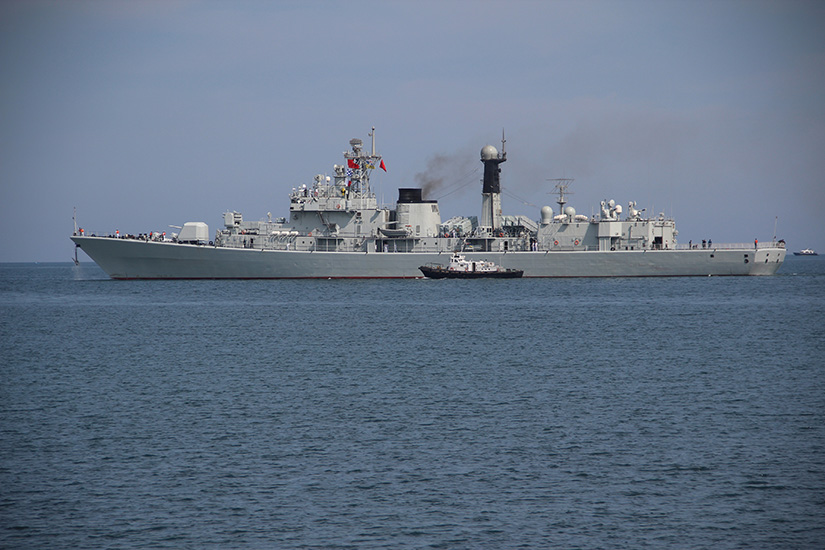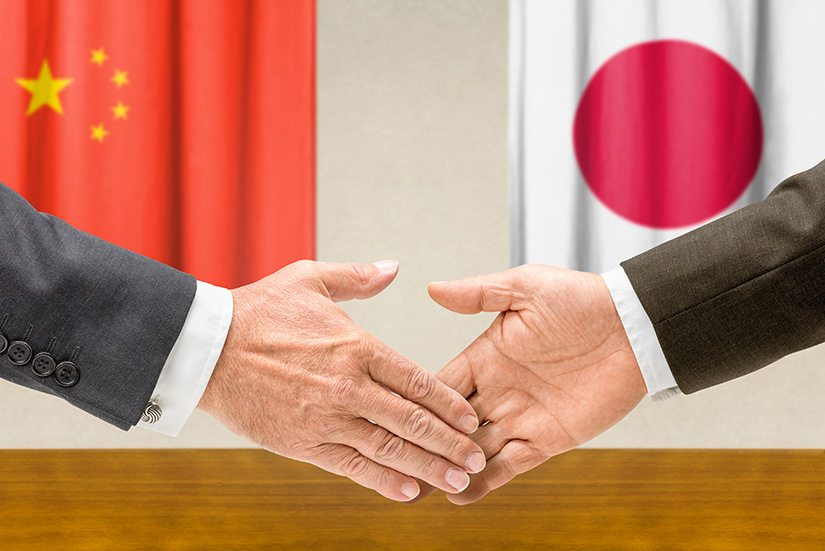Contents *Unauthorized reproduction is prohibited
SPF China Observer
HOMENo.60 2025/03/12
Requestioning the Meaning of “Peaceful Settlement”
Visit to Beijing brought a renewed realization of the Japan-China perception gap
Katsuya Yamamoto (Program Director and Senior Research Fellow, The Sasakawa Peace Foundation)
In December 2024, I had an opportunity to make a visit to Beijing for the first time since I retired from the Japan Self-Defense Forces (JSDF) and became a civilian. This visit became an occasion to realize anew that after half a century since the normalization of diplomatic relations, there still remains a profound perception gap between Japan and China. In this article, I would like to introduce some examples.

CIISS is not an academic association
The visit to China was prompted by an invitation extended from the China Institute for International Strategic Studies (CIISS) to the Sasakawa Japan-China Friendship Fund (SJCFF)[1].
The CIISS is one of the co-organizers of the Beijing Xiangshan Forum[2], also known as China’s version of the Shangri-La Dialogue, and self-claims to be a “non-governmental academic group that studies international issues.”[3]
In Japan, there are similarly named academic associations, such as the Japan Association for International Security (JAIS), the Japan Society of Strategic Studies (JSSS), and the Japan Society for Defense Studies (JSDS). Therefore, those of us in Japan are tempted to assume that the CIISS is, just like the JAIS, the JSSS, and the JSDS, a spontaneously organized and self-operated group of researchers engaging in academic research activities in their field of expertise.[4] However, the CIISS is in reality annexed to the People’s Liberation Army (PLA) of China, though this fact is little known in Japan. As obvious from its website, the CIISS is in effect an organ of the Joint Staff Department (formerly General Staff Department) of the Central Military Commission (JSDCMC), in which active-duty flag officers of the PLA serve on the Council, the leading body, and a majority of its management and research staff are PLA senior officers.[5]
The primary role of the CIISS is to interact and exchange opinions with security think tanks from other countries through such occasions as the Beijing Xiangshan Forum. At the same time, it also serves as a place for PLA officers in charge of international affairs, i.e., those to be stationed as military attachés or having returned from such assignments, to learn about the international relations and strategies. Most of its research staff are returnees from such overseas assignment and have experience of being stationed as a military attaché. Thus, they are also serving as a point of communication with defense/military research institutions and veteran communities in other countries.
Representatives of the CIISS do not hide the fact that their organization is a part of the PLA. Instead, they explain to us both openly and proudly the roles played by the CIISS. And yet, despite this obvious nature of the CIISS as an affiliate of the PLA, they have no hesitation to call it a “non-governmental academic group.” This suggests that China has a set of values different from ours and that there exists a significant perception gap between the two countries in the use and interpretation of certain terminology.
“Peaceful settlement” can be achieved by intimidation
At the CIISS, we met and discussed with, among others, a general having experience of serving as the director of the Third Department (Intelligence Department director) and being stationed in Russia and North Korea as a military attaché, a general with experience of being stationed the United States and serving as a member of the Permanent Mission of the People’s Republic of China (PRA) to the United Nations, and a general having experience of being stationed in Israel as a military attaché specialized in arms control. Also, through arrangements by the CIISS, we had an opportunity to meet and discuss with a general and other individuals engaging in strategy education and research at the PLA National Defense University.
These discussions made me realize first hand that there exists a profound perception gap between Japan and China in the use and interpretation of the term “peaceful settlement.”
When we voiced concerns about China’s aggressive activities, such as provocations against other countries around the South China Sea and military drills in and around the Taiwan Strait, those on the Chinese side said unanimously and repeatedly that China’s behavior does not at all contradict its goals of achieving a “peaceful settlement.”
From the viewpoint of Japan and many other members of the international community, China Coast Guard (CCG) ships’[6] aggressive actions[7], such as deliberately crashing into a coast guard ship of another country, and military exercises involving the launch of missiles into another country’s exclusive economic zone (EEZ)[8] are acts of violent intimidation and can by no means considered an “peaceful” approach.[9]

What became apparent through the discussions this time around is the fact that in China, even those PLA members, who are relatively well-informed about the international community, believe that bringing the other side to the table by conducting massive drills and taking a hardline stance against the backdrop of its military strength is one way of seeking a peaceful settlement.
The term “deterrence” translates to “抑止:yokushi” or “抑止力:yokushiryoku” in Japanese. What Japanese people would conjure up from the words “yokushi” and “yokushiryoku” used in the context of national security is to make proper preparations in order to prevent from being attacked.[10] That is, people typically consider “deterrence” a peaceful and defensive concept because the idea is to prevent invasion and protect their country. In contrast, the Chinse translation of the term “deterrence” is “威慑:wēishè,” which is equivalent to “威嚇:ikaku” in Japanese meaning intimidation. What I gathered from remarks made by the PLA members is that the term “deterrence” as used in China is not necessarily defensive in nature but includes more aggressive and intimidating attributions. This exactly reflects the nature of China, a country that translates “deterrence” to “wēishè.”
In 2022, the government of Prime Minister Fumio Kishida established new National Security Strategy (NSS) and National Defense Strategy (NDS) that call for acquiring the so-called “counterstrike capabilities,” such as stand-off defense capabilities, to deter invasion into Japan. This invited harsh criticism from China, which said: “Japan’s possession of such capabilities not only constitutes devastating destruction to the (Allies’) victory in the world’s war against fascism (referring to the World War II), but it also amounts to a grave infringement on the dignity of history and peace in the region.”[11]
Japan considers these counterstrike capabilities a means of “yokushiryoku” or “deterrence” as defined in Japan, but China must have thought that these capabilities would be used as a means of “wēishè” or “deterrence” as defined in China. For China, that might have been a natural conclusion, that is, when seeing things in the mirror image of its own “deterrence” actions or the way of its behavior.
Conclusion
China believes that intimidating its opponent with a show of military power—such as launching missiles and having its ships deliberately crash into those of the opponent—is within the scope of “deterrence” and that forcing the opponent into submission to its will with the use of such intimidation is a form of “peaceful settlement,” but it is beyond our understanding to consider such behavior a means of peaceful settlement. As such, there exists a profound gap between Japan and China.
A certain action taken by China, which Beijing considers within the scope of “peaceful settlement,” may look like an act of intimidation to those on the other side, prompting them to respond based on the perception that China is using (or about to use) of force against them. Such an ominous scenario could easily become reality. From our point of view, it is China that raised the escalation ladder, but China would accuse us of raising the escalation ladder. Throughout human history, there have been countless tragedies in which a misreading of the intent of the opponent culminated into war.
In 2007, Prime Minister Shinzo Abe and Chinese Premier Wen Jiabao agreed to establish a maritime and aerial communication mechanism[12] between the two countries, but it was only in 2023 that the Japanese and Chinese defense ministers hold their first phone call across a newly established hotline under the mechanism[13]. Today, there is an urgent need for Japan and China to dissolve the existing perception gap by understanding each other’s intent without misperceptions. That is one reason behind earnestly hoping for the truly effective operation of the hotline.

1 The Sasakawa Japan-China Friendship Fund (SJCFF) is one of the key branches of the Sasakawa Peace Foundation (SPF). With the help of Japan’s Ministry of Defense and China’s Ministry of National Defense, it has been promoting the Japan-China Field Officer Exchange Program since 2001 to foster mutual understanding by providing Japanese and Chinese field officers—those upon whose shoulders the futures of the JSDF and the People’s Liberation Army (PLA) of China rest—with an opportunity to engage in continuous dialogue.
“Nichi-Chu Sakan-kyu Koryu Jigyo: Jieitai Sakan-kyu Ho-Chu Puroguramu o Jisshi [Japan-China Field Officer Exchange Program: JSDF Field Officers Made a Visit to China],” SPF, December 9, 2024.
2 The Beijing Xiangshan Forum (formerly Xiangshan Forum) is an international conference launched by the China Association of Military Science (CAMS) in 2006 as a Track 2 platform for dialogue on security issues in the Asia-Pacific region. Starting from the fifth round in 2014, the forum has been held as a Track 1.5 dialogue, which means a significant upgrade and expansion, to involve participants ranging from defense and military leaders and representatives of international organization to former military officers, politicians, and renowned scholars. Starting from the sixth round in 2015, the forum has been co-hosted with the CIISS.
“Introduction,” Beijing Xiangshan Forum.
3 “Character and Intent,” CIISS
4 Regarding academic association and societies in Japan, see “Nihon Gakujutsu Kaigi Kyoryoku Gakujutsu Kenkyu Dantai [Cooperative Science and Research Bodies],” Science Council of Japan, Accessed February 17, 2025.
5 “Organization,” CIISS, Accessed February 17, 2025. A retired deputy chief of staff of the JSDCMC (general or lieutenant general) serves as an honorary chairman and the positions of chairman and vice chairman are filled by those who currently or used to hold the position of assistant chief of staff or director of the Intelligence Bureau/Department (major general), showing that the CIISS is a PLA-affiliated unit engaging in strategy making operations. In China, retired senior officers, i.e., those who are no longer on active duty, are accorded the same courtesy and treatment as they were entitled to when they were on active duty, and allowed to wear military clothes when deemed necessary.
6 In Japan, CCG ships are often referred to as “Chugoku Kaikei-sen” or “Chugoku kosen,” which literally translate into “Chinese marine police ship” and “Chinese government ship” respectively. However, China considers the CCG a part of the armed forces (armed police) and claims that ships operated by the CCG are warships, using the term “jiàn” (pronounced kan in Japanese) in referring to them. This article (in Japanese) refers to CCG ships as “Chugoku Kaikei-kan” as claimed by China. For details, see my article “The China Coast Guard as a Part of the China Communist Party’s Armed Forces,” International Information Network Analysis (IINA), November 17, 2020.
7 Regarding those actions, see, for example, “Firipin: Chugoku to Minami Shinakai de takamaru kincho, boku noryoku mo kyoka e [Philippines: Moving to enhance air defense capabilities amid rising tensions with China over the South China Sea],” NHK, October 12, 2024.
8 Exclusive economic zones (EEZs) are different from territorial seas in status, and conducting military activities in international waters, including foreign EEZs, is not per se illegal under international law.
9 For instance, see my article “‘Chugoku misairu, Nihon no EEZ rakka’ ga shimesu Nihon no moten [Japan’s blind spot shown by ‘Chinese missiles landing in Japan’s EEZ’],” Toyo Keizai Online, August 10, 2022.
10 Sugio Takahashi, “Perspective: Significance of Deterrence,” Defense of Japan 2024, Ministry of Defense, 2024.
11 “Rìběn gòujiàn ‘fǎnjí nénglì’ pòhuài dìqū ānquán[Japan to build ‘counterstrike capabilities’ that would undermine regional security],” China Military, December 9, 2022.
12 “Japan-China Joint Press Statement (Provisional Translation),” Ministry of Foreign Affairs, April 11, 2007.
13 “First telephone call of the Hotline Between Japan-China Defense Authorities by Japanese and Chinese Defense Ministers,” Ministry of Defense, May 16, 2023.





